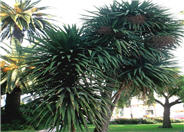
Common name:Australian-Dracaena
Botanical name:Cordyline australis
Cordyline australis is an evergreen shrub that grows 12' to 30' tall and 10' to 15' wide with sword-like leaves. It likes full sun, and is very tolerant of heat and drought. It will live in any type of soil that is well drained. Cut back to develop multiple trunks. This plant can be invasive in some areas, so use caution.

Common name:Carrotwood, Cupania
Botanical name:Cupaniopsis anacardioides
This evergreen tree will grow up to 40' high and has leathery, dark green leaves. When the trees approach maturity, yellow to orange fruit may be produced; it does well in wet soil.

Common name:Bougainvillea, Barbara Karst
Botanical name:Bougainvillea 'Barbara Karst'
The large amount of flamboyant color on this species creates a wonderful accent in a garden. Varieties can be in bush or vine form; colors vary. Once established, they tend to be carefree. All varieties are susceptible to frost damage. The 'Barbara Karst' variety blooms bright red in full sun; more crimson if in shade. It blooms early and long. It is senstive to frost and will die back hard but comes back in a number of weeks. Be carefeul of this in the Santa Ynez Valley.
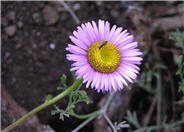
Common name:Blue Beach Aster, Seaside Daisy
Botanical name:Erigeron glaucus
This perennial will grow 1' tall and 1.5' wide. It has blue green foliage and lavender flowers that bloom in spring and summer.
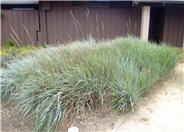
Common name:Canyon Prince Wild Rye
Botanical name:Leymus condensatus 'Canyon Prince'
One of the best known and utilized native grass selections in Southern California, this beautiful, blue gray foliage spreads out 3'-4' or more. It will reach a height of 2'-3'. It rarely flowers. It does spread by rhizomes although not as vigorously as some closely related species. It can be extremely drought tolerant and care must be taken not to over water this species as it can rot from the center. Otherwise, it is carefree and requires virtually no maintenance.
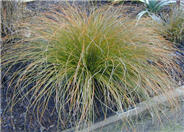
Common name:Orange Sedge
Botanical name:Carex testacea
Brown Sedge is an evergreen perennial that reaches 2' tall bearing very narrow, coppery brown leaves splitting to hair-like threads at their tips, and continuing to grow to 4'-8' in length. This plant should be grown in sun with little or no summer watering.
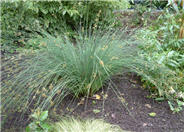
Common name:California Gray Rush
Botanical name:Juncus patens
Although a wetland plant, Juncus patens can tolerate fairly dry conditions. It will slowly clump to 2'-3' wide and a height of 2'-2.5'. There are many selections of this species available with different heights and widths. It is carefree, with little to no maintenance. It provides great upright structure to many styles of landscapes.
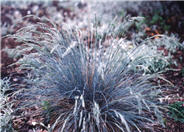
Common name:Rainbow Fescue
Botanical name:Festuca amethystima 'Superba'
The Rainbow Fescue is a hardy fescue with fine, blue green foliage that grows 8" tall. It has spring flowers that are 12" above the foliage. This fescue is a very showy, neat grass for sunny spots during spring and fall. The Rainbow Fescue is drought tolerant.
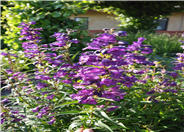
Common name:Garnet Penstemon
Botanical name:Penstemon 'Purple'
The Border Penstemon is a showy perennial that reaches 2'-4' in height. It has purple, tubular blossoms with red-striped throats on long flower spikes that bloom from spring through the fall. It is hardy to 15 degrees F. It is also drought tolerant, and attracts hummingbirds and butterflies.
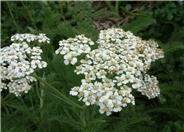
Common name:Yarrow
Botanical name:Achillea millefolium
This Achillea features spreading mats of fern-like rosettes, along with deeply divided leaves of a green or gray green color. In this form, the flowers are usually a white tone. Stems can reach 2'-3' above foliage. Yarrows propagate easily from rooted cuttings or division, which should be performed in the early spring or fall. Following bloom, one should dead head the plant and divide the clumps when it appears crowded.

Common name:Blue Sedge
Botanical name:Carex glauca
Carex 'Frosty Curls' is actually likely C. albula rather than C.comans but is well confused in the nursery industry. 'Frosty Curls' belongs to the group of New Zealand sedges that prefer well drained, drier conditions than other sedges typically prefer. If planted in inundated conditions, this sedge may struggle significantly. Otherwise, planted in groups or individually, it can be quite spectacular and carefree, providing foliage interest year round with light, almost silver weeping foliage.
Sustainable Landscaping Fundamentals
Sustainable landscaping is a term coined to mean sensible landscape practices that work within the limits of the Eco-system. This means within the limits of your local rainfall, soil conditions and sun patterns.
Click in the green box for more information
| Designer: Carmichael Environmental | Carmichael's Colors |
Photographer: GardenSoft |
Soils and Compost:
Incorporate compost 6" into your soil to retain water, reduce compaction, feed earthworms, and provide valuable nutrients to your plants.
Water Saving Tip:
Be sure to fix all leaks promptly no matter how small they may seem.
Integrated Pest Management:
Attract, or buy beneficial insects such as ladybugs and lacewings to control pest outbreaks in your garden.

